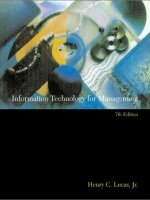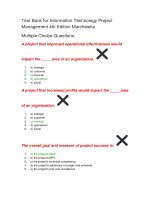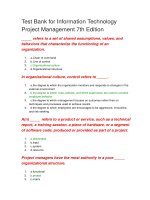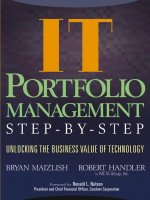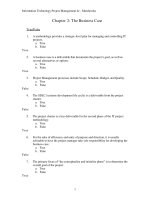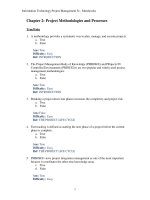INFORMATION TECHNOLOGY PROJECT MANAGEMENT
Bạn đang xem bản rút gọn của tài liệu. Xem và tải ngay bản đầy đủ của tài liệu tại đây (23.08 MB, 675 trang )
INFORMATION TECHNOLOGY
PROJECT MANAGEMENT
Copyright 2012 Cengage Learning. All Rights Reserved. May not be copied, scanned, or duplicated, in whole or in part.
Copyright 2012 Cengage Learning. All Rights Reserved. May not be copied, scanned, or duplicated, in whole or in part.
INFORMATION TECHNOLOGY
PROJECT MANAGEMENT
Seventh Edition
Kathy Schwalbe, Ph.D., PMP
Augsburg College
Australia • Brazil • Japan • Korea • Mexico • Singapore • Spain • United Kingdom • United States
Copyright 2012 Cengage Learning. All Rights Reserved. May not be copied, scanned, or duplicated, in whole or in part.
This is an electronic version of the print textbook. Due to electronic rights restrictions, some third party content may be suppressed. Editorial
review has deemed that any suppressed content does not materially affect the overall learning experience. The publisher reserves the right to
remove content from this title at any time if subsequent rights restrictions require it. For valuable information on pricing, previous
editions, changes to current editions, and alternate formats, please visit www.cengage.com/highered to search by
ISBN#, author, title, or keyword for materials in your areas of interest.
Copyright 2012 Cengage Learning. All Rights Reserved. May not be copied, scanned, or duplicated, in whole or in part.
Information Technology Project Management,
Seventh Edition
Kathy Schwalbe
Editorial Director: Erin Joyner
Editor-in-Chief: Joe Sabatino
Sr. Acquisition Editor: Charles McCormick, Jr.
Sr. Project Manager: Kate Mason
Development Editor: Dan Seiter
Editorial Assistant: Anne Merrill
Sr. Brand Manager: Robin LeFevre
Market Development Manager: Jon Monahan
Marketing Coordinator: Mike Saver
Art and Cover Direction, Production
Management, and Composition: PreMediaGlobal
Media Editor: Chris Valentine
Rights Acquisition Director: Audrey Pettengill
Rights Acquisition Specialist, Text and Image:
John Hill
Manufacturing Planner: Julio Esperas
Cover Images: © Redshinestudio/Shutterstock
© 2014 Course Technology, Cengage Learning
ALL RIGHTS RESERVED. No part of this work covered by the copyright
herein may be reproduced, transmitted, stored or used in any form or by
any means—graphic, electronic, or mechanical, including but not limited
to photocopying, recording, scanning, digitizing, taping, Web distribution,
information networks, or information storage and retrieval systems,
except as permitted under Section 107 or 108 of the 1976 United States
Copyright Act—without the prior written permission of the publisher.
For product information and technology assistance, contact
Cengage Learning Customer & Sales Support, 1-800-354-9706.
For permission to use material from this text or product,
submit all requests online at cengage.com/permissions
Further permissions questions can be e-mailed to
Library of Congress Control Number: 2012946635
Student Edition:
Instructor’s Edition:
ISBN-13: 978-1-133-52685-8
ISBN-13: 978-1-133-52687-2
ISBN-10: 1-133-52685-3
ISBN-10: 1-133-52687-X
Course Technology
20 Channel Center Street
Boston, MA 02210
USA
Screenshots for this book were created using Microsoft Project, and were used with
permission from Microsoft.
Microsoft and the Office logo are either registered trademarks or trademarks of Microsoft
Corporation in the United States and/or other countries. Course Technology, a part of Cengage
Learning, is an independent entity from the Microsoft Corporation, and not affiliated with
Microsoft in any manner.
Screenshots from AtTask and MindView Business software are used with permission from
AtTask, Inc. and MatchWare. iPhone, iPad, iPod, and MacBook are registered trademarks of
Apple Inc.
Information pertaining to Northwest Airlines was used with their express permission. No
part of it may be reproduced or used in any form without prior written permission from
Course Technology.
Some material in this book is reprinted from the PMBOK® Guide, Fifth Edition (©2012 Project
Management Institute, Inc., all rights reserved). This material is used with permission of the
Project Management Institute, Inc., Four Campus Boulevard, Newtown Square, PA 19073-2399,
USA; phone (610) 356-4600; fax (610) 356-4647; Web site www.pmi.org. PMI is the world’s
leading project management association, with more than 380,000 members worldwide.
PMI, PMP, and PMBOK are registered marks of the Project Management Institute, Inc.
Some of the product names and company names used in this book have been used for
identification purposes only and may be trademarks or registered trademarks of their
respective manufacturers and sellers.
Course Technology, a part of Cengage Learning, reserves the right to revise this publication
and make changes from time to time in its content without notice.
Cengage Learning is a leading provider of customized learning solutions with office
locations around the globe, including Singapore, the United Kingdom, Australia, Mexico,
Brazil, and Japan. Locate your local office at: www.cengage.com/global
Cengage Learning products are represented in Canada by Nelson Education, Ltd.
To learn more about Course Technology, visit www.cengage.com/coursetechnology
Purchase any of our products at your local college store or at our preferred
online store www.cengagebrain.com
Printed in the United States of America
1 2 3 4 5 6 7 16 15 14 13 12
Copyright 2012 Cengage Learning. All Rights Reserved. May not be copied, scanned, or duplicated, in whole or in part.
For Dan, Anne, Bobby, and Scott
Copyright 2012 Cengage Learning. All Rights Reserved. May not be copied, scanned, or duplicated, in whole or in part.
Copyright 2012 Cengage Learning. All Rights Reserved. May not be copied, scanned, or duplicated, in whole or in part.
BRIEF CONTENTS
Preface
xix
Chapter 1
Introduction to Project Management
1
Chapter 2
The Project Management and Information Technology Context
43
Chapter 3
The Project Management Process Groups: A Case Study
81
Chapter 4
Project Integration Management
139
Chapter 5
Project Scope Management
187
Chapter 6
Project Time Management
225
Chapter 7
Project Cost Management
271
Chapter 8
Project Quality Management
311
Chapter 9
Project Human Resource Management
359
Chapter 10
Project Communications Management
405
Chapter 11
Project Risk Management
439
Copyright 2012 Cengage Learning. All Rights Reserved. May not be copied, scanned, or duplicated, in whole or in part.
viii
Brief Contents
Chapter 12
Project Procurement Management
479
Chapter 13
Project Stakeholder Management
509
Appendix A
Guide to Using Microsoft Project 2010
A.1
Appendix B
(Available on CengageBrain.com)
Appendix C
(Available on CengageBrain.com)
Glossary
Index
G.1
I.1
Copyright 2012 Cengage Learning. All Rights Reserved. May not be copied, scanned, or duplicated, in whole or in part.
T A B L E OF CO N T E N T S
Preface
Chapter 1
xix
Introduction to Project Management
1
Introduction
What Is a Project?
Examples of IT Projects
Project Attributes
Project Constraints
What Is Project Management?
Project Stakeholders
Project Management Knowledge Areas
Project Management Tools and Techniques
Project Success
Program and Project Portfolio Management
Programs
Project Portfolio Management
The Role of the Project Manager
Project Manager Job Description
Suggested Skills for Project Managers
Importance of People Skills and Leadership Skills
Careers for IT Project Managers
The Project Management Profession
History of Project Management
The Project Management Institute
Project Management Certification
Ethics in Project Management
Project Management Software
Chapter Summary
Quick Quiz
Quick Quiz Answers
Discussion Questions
Exercises
Key Terms
End Notes
2
4
4
6
7
9
10
11
12
14
16
17
17
21
21
22
24
25
26
26
30
30
32
33
36
37
38
38
39
40
41
Chapter 2
The Project Management and Information Technology Context
A Systems View of Project Management
What Is a Systems Approach?
The Three-Sphere Model for Systems Management
43
45
45
46
Copyright 2012 Cengage Learning. All Rights Reserved. May not be copied, scanned, or duplicated, in whole or in part.
x
Table of Contents
Understanding Organizations
The Four Frames of Organizations
Organizational Structures
Organizational Culture
Stakeholder Management
The Importance of Top Management Commitment
The Need for Organizational Commitment to Information Technology
The Need for Organizational Standards
Project Phases and the Project Life Cycle
Product Life Cycles
The Importance of Project Phases and Management Reviews
The Context of Information Technology Projects
The Nature of IT Projects
Characteristics of IT Project Team Members
Diverse Technologies
Recent Trends Affecting Information Technology Project Management
Globalization
Outsourcing
Virtual Teams
Agile Project Management
The Manifesto for Agile Software Development
Scrum
Agile, the PMBOK® Guide, and a New Certification
Chapter Summary
Quick Quiz
Quick Quiz Answers
Discussion Questions
Exercises
Key Terms
End Notes
Chapter 3
47
47
49
51
52
54
55
56
56
59
62
64
64
64
65
65
65
66
67
69
70
70
71
73
74
75
75
76
77
78
The Project Management Process Groups: A Case Study
81
Project Management Process Groups
Mapping the Process Groups to the Knowledge Areas
Developing an IT Project Management Methodology
Case Study 1: JWD Consulting’s Project Management Intranet Site Project
(Predictive Approach)
Project Pre-Initiation and Initiation
Pre-Initiation Tasks
Initiating
Project Planning
Project Execution
Project Monitoring and Controlling
Project Closing
Case Study 2: JWD Consulting’s Project Management Intranet Site Project
(Agile Approach)
Scrum Roles, Artifacts, and Ceremonies
Project Pre-Initiation and Initiation
Planning
82
87
88
91
91
92
96
100
109
114
117
120
121
123
124
Copyright 2012 Cengage Learning. All Rights Reserved. May not be copied, scanned, or duplicated, in whole or in part.
Table of Contents
Executing
Monitoring and Controlling
Closing
Templates by Process Group
Chapter Summary
Quick Quiz
Quick Quiz Answers
Discussion Questions
Exercises
Key Terms
End Notes
Chapter 4
Project Integration Management
What Is Project Integration Management?
Strategic Planning and Project Selection
Strategic Planning
Identifying Potential Projects
Aligning IT with Business Strategy
Methods for Selecting Projects
Focusing on Broad Organizational Needs
Categorizing IT Projects
Performing Net Present Value Analysis, Return on Investment, and Payback
Analysis
Net Present Value Analysis
Return on Investment
Payback Analysis
Using a Weighted Scoring Model
Implementing a Balanced Scorecard
Developing a Project Charter
Developing a Project Management Plan
Project Management Plan Contents
Using Guidelines to Create Project Management Plans
Directing and Managing Project Work
Coordinating Planning and Execution
Providing Strong Leadership and a Supportive Culture
Capitalizing on Product, Business, and Application Area Knowledge
Project Execution Tools and Techniques
Monitoring and Controlling Project Work
Performing Integrated Change Control
Change Control on IT Projects
Change Control System
Closing Projects or Phases
Using Software to Assist in Project Integration Management
Chapter Summary
Quick Quiz
Quick Quiz Answers
Discussion Questions
127
127
129
129
133
133
135
135
136
137
138
139
140
143
143
145
146
148
148
148
149
149
152
153
154
156
157
161
161
164
166
166
167
167
168
169
171
172
173
175
175
178
178
180
180
Copyright 2012 Cengage Learning. All Rights Reserved. May not be copied, scanned, or duplicated, in whole or in part.
xi
xii
Table of Contents
Exercises
Running Case
Tasks
Key Terms
End Notes
Chapter 5
Project Scope Management
What Is Project Scope Management?
Planning Scope Management
Collecting Requirements
Defining Scope
Creating the Work Breakdown Structure
Approaches to Developing Work Breakdown Structures
Using Guidelines
The Analogy Approach
The Top-Down and Bottom-Up Approaches
Mind Mapping
The WBS Dictionary
Advice for Creating a WBS and WBS Dictionary
Validating Scope
Controlling Scope
Suggestions for Improving User Input
Suggestions for Reducing Incomplete and Changing Requirements
Using Software to Assist in Project Scope Management
Chapter Summary
Quick Quiz
Quick Quiz Answers
Discussion Questions
Exercises
Running Case
Tasks
Key Terms
End Notes
Chapter 6
Project Time Management
The Importance of Project Schedules
Planning Schedule Management
Defining Activities
Sequencing Activities
Dependencies
Network Diagrams
Estimating Activity Resources
Estimating Activity Durations
Developing the Schedule
Gantt Charts
Adding Milestones to Gantt Charts
Using Tracking Gantt Charts to Compare Planned and Actual Dates
Critical Path Method
Calculating the Critical Path
Growing Grass Can Be on the Critical Path
181
182
183
184
185
187
188
189
191
194
198
203
203
204
204
205
206
207
208
210
212
212
214
216
216
218
218
219
220
221
221
222
225
226
229
229
232
232
233
236
237
238
238
240
241
243
243
244
Copyright 2012 Cengage Learning. All Rights Reserved. May not be copied, scanned, or duplicated, in whole or in part.
Table of Contents
Using Critical Path Analysis to Make Schedule Trade-Offs
Using the Critical Path to Shorten a Project Schedule
Importance of Updating Critical Path Data
Critical Chain Scheduling
Program Evaluation and Review Technique (PERT)
Controlling the Schedule
Reality Checks on Scheduling and the Need for Discipline
Using Software to Assist in Project Time Management
Words of Caution on Using Project Management Software
Chapter Summary
Quick Quiz
Quick Quiz Answers
Discussion Questions
Exercises
Running Case
Tasks
Key Terms
End Notes
Chapter 7
Project Cost Management
The Importance of Project Cost Management
What Is Cost?
What Is Project Cost Management?
Basic Principles of Cost Management
Planning Cost Management
Estimating Costs
Types of Cost Estimates
Cost Estimation Tools and Techniques
Typical Problems with IT Cost Estimates
Sample Cost Estimate
Determining the Budget
Controlling Costs
Earned Value Management
Project Portfolio Management
Using Project Management Software to Assist in Project Cost Management
Chapter Summary
Quick Quiz
Quick Quiz Answers
Discussion Questions
Exercises
Running Case
Tasks
Key Terms
End Notes
Chapter 8
Project Quality Management
The Importance of Project Quality Management
What Is Project Quality Management?
Planning Quality Management
Performing Quality Assurance
245
247
248
248
251
252
253
255
256
258
259
261
261
261
265
265
265
268
271
272
274
274
275
279
280
280
282
283
284
289
291
291
297
299
301
301
303
303
304
305
305
306
308
311
312
314
316
318
Copyright 2012 Cengage Learning. All Rights Reserved. May not be copied, scanned, or duplicated, in whole or in part.
xiii
xiv
Table of Contents
Controlling Quality
Tools and Techniques for Quality Control
Statistical Sampling
Six Sigma
How Is Six Sigma Quality Control Unique?
Six Sigma and Project Selection and Management
Six Sigma and Statistics
Testing
Modern Quality Management
Deming and His 14 Points for Management
Juran and the Importance of Top Management Commitment to Quality
Crosby and Striving for Zero Defects
Ishikawa’s Guide to Quality Control
Taguchi and Robust Design Methods
Feigenbaum and Workers’ Responsibility for Quality
Malcolm Baldrige National Quality Award
ISO Standards
Improving IT Project Quality
Leadership
The Cost of Quality
Organizational Influences, Workplace Factors, and Quality
Expectations and Cultural Differences in Quality
Maturity Models
Software Quality Function Deployment Model
Capability Maturity Model Integration
Project Management Maturity Models
Using Software to Assist in Project Quality Management
Chapter Summary
Quick Quiz
Quick Quiz Answers
Discussion Questions
Exercises
Running Case
Tasks
Key Terms
End Notes
Chapter 9
319
320
327
328
329
330
331
333
335
336
336
337
338
338
338
338
339
340
340
341
343
343
344
344
344
345
347
348
348
350
350
351
352
352
352
355
Project Human Resource Management
359
The Importance of Human Resource Management
The Global IT Workforce
Implications for the Future of IT Human Resource Management
What Is Project Human Resource Management?
Keys to Managing People
Motivation Theories
Maslow’s Hierarchy of Needs
Herzberg’s Motivation-Hygiene Theory
McClelland’s Acquired-Needs Theory
McGregor’s Theory X and Theory Y
Thamhain and Wilemon’s Influence and Power
360
360
361
363
365
365
365
366
367
368
368
Copyright 2012 Cengage Learning. All Rights Reserved. May not be copied, scanned, or duplicated, in whole or in part.
Table of Contents
Covey and Improving Effectiveness
Developing the Human Resource Plan
Project Organizational Charts
Responsibility Assignment Matrices
Staffing Management Plans and Resource Histograms
Acquiring the Project Team
Resource Assignment
Resource Loading
Resource Leveling
Developing the Project Team
Training
Team-Building Activities
The Myers-Briggs Type Indicator
The Social Styles Profile
DISC Profile
Reward and Recognition Systems
Managing the Project Team
Tools and Techniques for Managing Project Teams
General Advice on Managing Teams
Using Software to Assist in Human Resource Management
Chapter Summary
Quick Quiz
Quick Quiz Answers
Discussion Questions
Exercises
Running Case
Key Terms
End Notes
Chapter 10
Project Communications Management
The Importance of Project Communications Management
Keys to Good Communications
Focusing on Group and Individual Communication Needs
Formal and Informal Methods for Communicating
Distributing Important Information in an Effective and Timely Manner
Setting the Stage for Communicating Bad News
Determining the Number of Communication Channels
Planning Communications Management
Managing Communications
Using Technology to Enhance Information Creation and Distribution
Selecting the Appropriate Communication Methods and Media
Reporting Performance
Controlling Communications
Suggestions for Improving Project Communications
Developing Better Communication Skills
Running Effective Meetings
Using E-Mail, Instant Messaging, Texting, and Collaborative Tools Effectively
Using Templates for Project Communications
Using Software to Assist in Project Communications
370
373
374
376
377
378
379
381
383
384
385
386
386
388
389
390
390
391
393
394
396
397
399
399
399
400
401
402
405
406
408
409
410
411
412
412
414
416
416
417
420
420
421
421
423
424
427
430
Copyright 2012 Cengage Learning. All Rights Reserved. May not be copied, scanned, or duplicated, in whole or in part.
xv
xvi
Table of Contents
Chapter Summary
Quick Quiz
Quick Quiz Answers
Discussion Questions
Exercises
Running Case
Key Terms
End Notes
Chapter 11
Project Risk Management
The Importance of Project Risk Management
Planning Risk Management
Common Sources of Risk on IT Projects
Identifying Risks
Suggestions for Identifying Risks
The Risk Register
Performing Qualitative Risk Analysis
Using Probability/Impact Matrixes to Calculate Risk Factors
Top Ten Risk Item Tracking
Performing Quantitative Risk Analysis
Decision Trees and Expected Monetary Value
Simulation
Sensitivity Analysis
Planning Risk Responses
Controlling Risks
Using Software to Assist in Project Risk Management
Chapter Summary
Quick Quiz
Quick Quiz Answers
Discussion Questions
Exercises
Running Case
Key Terms
End Notes
Chapter 12
433
433
435
435
435
436
437
437
439
440
447
448
452
453
455
457
457
459
461
461
463
465
467
469
469
471
472
474
474
474
475
476
478
Project Procurement Management
479
The Importance of Project Procurement Management
Planning Procurement Management
Types of Contracts
Tools and Techniques for Planning Procurement Management
Make-or-Buy Analysis
Expert Judgment
Market Research
Procurement Management Plan
Statement of Work
Procurement Documents
Source Selection Criteria
Conducting Procurements
Controlling Procurements
Closing Procurements
480
483
485
489
489
490
490
491
491
493
494
495
497
499
Copyright 2012 Cengage Learning. All Rights Reserved. May not be copied, scanned, or duplicated, in whole or in part.
Table of Contents
Using Software to Assist in Project Procurement Management
Chapter Summary
Quick Quiz
Quick Quiz Answers
Discussion Questions
Exercises
Running Case
Key Terms
End Notes
Chapter 13
Project Stakeholder Management
The Importance of Project Stakeholder Management
Identifying Stakeholders
Planning Stakeholder Management
Managing Stakeholder Engagement
Controlling Stakeholder Engagement
Using Software to Assist in Project Stakeholder Management
Chapter Summary
Quick Quiz
Quick Quiz Answers
Discussion Questions
Exercises
Running Case
Key Terms
End Notes
Appendix A
499
502
503
504
504
505
505
506
507
509
510
512
516
516
519
522
524
524
526
526
526
527
527
527
Guide to Using Microsoft Project 2010
A.1
Introduction
New Features of Project 2010
Before You Begin
Overview of Project 2010
Starting Project 2010 and Using the Help Feature
Main Screen Elements
Project 2010 Views
Project 2010 Filters
Project Scope Management
Creating a New Project File
Developing a Work Breakdown Structure
Creating Summary Tasks
Numbering Tasks
Saving Project Files with or without a Baseline
Project Time Management
Manual and Automatic Scheduling
Entering Task Durations
Establishing Task Dependencies
Changing Task Dependency Types and Adding Lead or Lag Time
Gantt Charts
Network Diagrams
Critical Path Analysis
A.2
A.3
A.4
A.5
A.5
A.7
A.11
A.15
A.17
A.17
A.20
A.22
A.23
A.24
A.24
A.24
A.25
A.30
A.33
A.36
A.38
A.40
Copyright 2012 Cengage Learning. All Rights Reserved. May not be copied, scanned, or duplicated, in whole or in part.
xvii
xviii
Table of Contents
Project Cost Management
Fixed and Variable Cost Estimates
Entering Fixed Costs in the Cost Table
Entering Human Resource Costs
Adjusting Resource Costs
Assigning Resources to Tasks
Assigning Resources Using the Entry Table
Assigning Resources Using the Resource Tab
Assigning Resources Using the Split Window
Viewing Project Cost Information
Baseline Plan, Actual Costs, and Actual Times
Establishing a Baseline Plan
Entering Actual Costs and Times
Earned Value Management
Project Human Resource Management
Resource Calendars
Resource Histograms
Resource Leveling
Using the New Team Planner Feature
Project Communications Management
Common Reports and Views
Using Templates and Inserting Hyperlinks and Comments
Discussion Questions
Exercises
Exercise A-1: Homework Assignments
HW1: Project 2010, Part 1 (100 points, 25 points for each item)
HW2: Project 2010, Part 2 (100 points, 25 points for each item)
Exercise A-2: Web Site Development
Exercise A-3: Software Training Program
Exercise A-4: Project Tracking Database
Exercise A-5: Real Project Application
A.42
A.43
A.43
A.43
A.44
A.45
A.45
A.46
A.47
A.49
A.51
A.51
A.52
A.57
A.60
A.60
A.61
A.63
A.65
A.66
A.66
A.68
A.72
A.72
A.72
A.72
A.73
A.73
A.75
A.76
A.79
Appendix B
(Available on CengageBrain.com)
Appendix C
(Available on CengageBrain.com)
Glossary
Index
G.1
I.1
Copyright 2012 Cengage Learning. All Rights Reserved. May not be copied, scanned, or duplicated, in whole or in part.
PREFACE
The future of many organizations depends on their ability to harness the power of
information technology, and good project managers continue to be in high demand.
Colleges have responded to this need by establishing courses in project management
and making them part of the information technology, management, engineering, and
other curricula. Corporations are investing in continuing education to help develop
effective project managers and project teams. This text provides a much-needed
framework for teaching courses in project management, especially those that emphasize managing information technology projects. The first six editions of this text were
extremely well received by people in academia and the workplace. The Seventh
Edition builds on the strengths of the previous editions and adds new, important
information and features.
It’s impossible to read a newspaper, magazine, or Web page without hearing about
the impact of information technology on our society. Information is traveling faster
and being shared by more people than ever before. You can buy just about anything
online, surf the Web on a mobile phone, or use a wireless Internet connection at your
local coffee shop. Companies have linked their systems together to help them fill
orders on time and better serve their customers. Software companies are continually
developing new products to help streamline our work and get better results. When
technology works well, it is almost invisible. But did it ever occur to you to ask, “Who
makes these complex technologies and systems happen?”
Because you’re reading this text, you must have an interest in the “behind-thescenes” aspects of technology. If I’ve done my job well, you’ll begin to see the many
innovations society is currently enjoying as the result of thousands of successful
information technology projects. In this text, you’ll read about IT projects around the
world that went well, including Mittal Steel Poland’s Implementation of SAP that unified IT systems to improve business and financial processes; Dell Earth and other
green computing projects that save energy and millions of dollars; Six Sigma projects
such as the project to improve case load management at Baptist St. Anthony’s
Hospital in Amarillo, Texas; the systems infrastructure project at the Boots Company
in the United Kingdom that takes advantage of supplier competition to cut costs and
improve services; and many more. Of course, not all projects are successful. Factors
such as time, money, and unrealistic expectations, among many others, can sabotage
a promising effort if it is not properly managed. In this text, you’ll also learn from the
mistakes made on many projects that were not successful. I have written this book in
an effort to educate you, tomorrow’s project managers, about what will help make a
project succeed—and what can make it fail. You’ll also see how projects are used in
everyday media, such as television and film, and how companies use best practices in
project management. Many readers tell me how much they enjoy reading these realworld examples in the What Went Right?, What Went Wrong?, Media Snapshot, and
Best Practice features. As practitioners know, there is no “one size fits all” solution to
Copyright 2012 Cengage Learning. All Rights Reserved. May not be copied, scanned, or duplicated, in whole or in part.
xx
Preface
managing projects. By seeing how different organizations successfully implement
project management, you can help your organization do the same.
Although project management has been an established field for many years,
managing information technology projects requires ideas and information that go
beyond standard project management. For example, many information technology
projects fail because of a lack of user input, incomplete and changing requirements,
and a lack of executive support. This book includes suggestions for dealing with these
issues. New technologies can also aid in managing information technology projects,
and examples of using software to assist in project management are included
throughout the book.
Information Technology Project Management, Seventh Edition, is the only textbook to apply all 10 project management knowledge areas and all five process groups
to information technology projects. As you will learn, the project management
knowledge areas are project integration, scope, time, cost, quality, human resource,
communications, risk, procurement, and stakeholder management. The five process
groups are initiating, planning, executing, monitoring and controlling, and closing.
This text builds on the PMBOK® Guide, Fifth Edition, an American National
Standard, to provide a solid framework and context for managing information technology projects. It also includes an appendix, Guide to Using Microsoft Project 2010,
that many readers find invaluable. A second appendix provides advice on earning and
maintaining Project Management Professional (PMP) certification from the Project
Management Institute (PMI) as well as information on other certification programs,
such as CompTIA’s Projectþ certification. A third appendix provides additional case
studies and information on using simulation and mind-mapping software to help
readers apply their project management skills.
Information Technology Project Management, Seventh Edition, provides practical
lessons in project management for students and practitioners alike. By weaving
together theory and practice, this text presents an understandable, integrated view of
the many concepts, skills, tools, and techniques of information technology project
management. The comprehensive design of the text provides a strong foundation for
students and practitioners in project management.
NEW TO THE SEVENTH EDITION
Building on the success of the previous editions, Information Technology Project
Management, Seventh Edition, introduces a uniquely effective combination of features. The main changes in the Seventh Edition include the following:
•
•
Several changes were made to synchronize the Seventh Edition with the
PMBOK® Guide, Fifth Edition. Changes were made based on the exposure
draft released in February 2012. The biggest change was the addition of a
tenth knowledge area, Project Stakeholder Management. This text includes a
new chapter to address this important topic.
Includes additional information on agile project management. Chapter 2
includes general information on this popular concept, and Chapter 3 provides
a second case study illustrating the outputs produced for the JWD Consulting
project when using an agile approach. For example, you can see a sample
product backlog, a sprint backlog, a burndown chart, and key artifacts or
outputs produced when using Scrum, the most popular agile method.
Copyright 2012 Cengage Learning. All Rights Reserved. May not be copied, scanned, or duplicated, in whole or in part.
Preface
•
•
•
•
•
Appendix C, Additional Cases and Software, provides information about using
several simulation software tools. Several suppliers offer discounts to users of
this text. A new section provides instructions for accessing a special 60-day
trial of MindView Business software. This software provides the capability to
create mind maps, a powerful tool for creating a SWOT analysis or work
breakdown structure. The software also allows users to convert a mind map
into a Gantt chart.
A new feature, Global Issues, provides examples of how project management
concepts and practices affect people around the globe.
Updated examples are provided throughout the text. You’ll notice several new
examples in the Seventh Edition that explain recent events in managing real
information technology projects. Several of the What Went Right?, What
Went Wrong?, Media Snapshot, and Best Practice examples have been
updated to keep you current. Additional examples and results of new studies
are included throughout the text, with appropriate citations.
User feedback is incorporated. Based on feedback from reviewers, students,
instructors, practitioners, and translators, you’ll see several additional
changes to help clarify information. (This book has been translated into
Chinese, Japanese, Russian, and Czech.)
A new CourseMate site for the Seventh Edition (www.cengagebrain.com)
provides access to informative links from the end notes, lecture notes, interactive quizzes, templates, additional running cases, suggested readings, and
many other items to enhance your learning.
ACCESSING THE COURSEMATE SITE
To access the CourseMate site, open a Web browser and go to www.cengage
brain.com. Search by ISBN, author name, or title, and click Create My Account
to begin the registration process.
APPROACH
Many people have been practicing some form of project management with little or no
formal study in this area. New books and articles are written each year as we discover
more about the field of project management, and project management software continues to advance. Because the project management field and the technology industry
change rapidly, you cannot assume that what worked even a few years ago is still the
best approach today. This text provides up-to-date information on how good project
management and effective use of software can help you manage projects, especially
information technology projects. Six distinct features of this text include its relationship to the Project Management Body of Knowledge, its detailed guide for using
Microsoft Project 2010, its value in preparing for Project Management Professional
and other certification exams, its inclusion of running case studies and online templates, its companion (premium) Web site, and its inclusion of a 60-day trial of
MindView Business software.
Copyright 2012 Cengage Learning. All Rights Reserved. May not be copied, scanned, or duplicated, in whole or in part.
xxi
xxii
Preface
Based on PMBOK® Guide, Fifth Edition
The Project Management Institute (PMI) created the Guide to the Project
Management Body of Knowledge (the PMBOK® Guide) as a framework and starting
point for understanding project management. It includes an introduction to project
management, brief descriptions of all 10 project management knowledge areas, and a
glossary of terms. The PMBOK® Guide is, however, just that—a guide. This text uses
the PMBOK® Guide, Fifth Edition exposure draft (2012) as a foundation, but goes
beyond it by providing more details, highlighting additional topics, and providing a
real-world context for project management. Information Technology Project
Management, Seventh Edition, explains project management specifically as it applies
to managing information technology projects in the 21st century. It includes several
unique features to bring you the excitement of this dynamic field. (For more information on features, see the Pedagogical Features section.)
Detailed Guide for How to Use Microsoft Project 2010
Software has advanced tremendously in recent years, and it is important for project
managers and their teams to use software to help manage information technology
projects. Information Technology Project Management, Seventh Edition, includes a
detailed guide in Appendix A for using the leading project management software on
the market—Microsoft Project 2010. Examples that use Project and other software
tools are integrated throughout the text. Appendix A, Guide to Using Microsoft Project
2010, teaches you in a systematic way to use this powerful software to help in project
scope, time, cost, human resource, and communications management.
Resource for PMP and Other Certification Exams
Professional certification is an important factor in recognizing and ensuring quality in
a profession. PMI provides certification as a Project Management Professional (PMP),
and this text is an excellent resource for studying for the certification exam as well as
the entry-level Certified Associate in Project Management (CAPM) exam. This text
will also help you pass other certification exams, such as CompTIA’s Project+ exam.
Having working experience on projects does not mean you can easily pass the PMP or
other certification exams.
I like to tell my students a story about taking a driver’s license test after moving to
Minnesota. I had been driving safely and without accidents for over 16 years, so I thought
I could just walk in and take the test. I was impressed by the sophisticated computer
system used to administer the test. The questions were displayed on a large touch-screen
monitor, often with an image or video to illustrate traffic signs or driving situations. I
became concerned when I had no idea how to answer several questions, and I was perplexed when the test seemed to stop and a message appeared: “Please see the person at
the service counter.” This was a polite way of saying I had failed the test! After controlling my embarrassment, I picked up one of the Minnesota driving test brochures, studied
it for an hour or two that night, and passed the test the next day.
The point of this story is to emphasize the importance of studying information
from the organization that creates the test and not to be overconfident that your
experience is enough. Because this text is based on PMI’s PMBOK® Guide, Fifth
Edition, it provides a valuable reference for studying for PMP certification. It is also
Copyright 2012 Cengage Learning. All Rights Reserved. May not be copied, scanned, or duplicated, in whole or in part.
Preface
an excellent reference for CompTIA’s Project+ exam. I have earned both of these
certifications and kept them in mind when writing this text.
Exercises, Running Cases, Templates, Sample Documents,
and Optional Simulation Software
Based on feedback from readers, the Seventh Edition continues to provide challenging exercises and running cases to help students apply concepts in each chapter. The
text includes more than 50 templates, examples of real project documents, and information on several simulation software tools that you can use to practice your skills in
managing a project. All of these features help the subject matter come alive and have
more meaning.
ORGANIZATION AND CONTENT
Information Technology Project Management, Seventh Edition, is organized into
three main sections to provide a framework for project management, a detailed
description of each project management knowledge area, and three appendices to
provide practical information for applying project management. The first three chapters form the first section, which introduces the project management framework and
sets the stage for the remaining chapters.
Chapters 4 through 13 form the second section of the text, which describes each
of the project management knowledge areas—project integration, scope, time, cost,
quality, human resource, communications, risk, procurement, and stakeholder management—in the context of information technology projects. An entire chapter is
dedicated to each knowledge area. Each of these chapters includes sections that map
to their major processes as described in the PMBOK® Guide, Fifth Edition. For
example, the chapter on project quality management includes sections on planning
quality management, performing quality assurance, and controlling quality. Additional
sections highlight other important concepts related to each knowledge area, such as
Six Sigma, testing, maturity models, and using software to assist in project quality
management. Each chapter also includes detailed examples of key project management tools and techniques as applied to information technology projects. For example, the chapter on project integration management includes samples of various
project-selection documents, such as net present value analyses, ROI calculations,
payback analyses, and weighted scoring models. The project scope management
chapter includes a sample project charter, a project scope statement, and several
work breakdown structures for information technology projects.
Appendices A through C form the third section of the text, which provides
practical information to help you apply project management skills to real or
practice projects. By following the detailed, step-by-step guide in Appendix A, which
includes more than 60 screen illustrations, you will learn how to use Project 2010.
Appendix B summarizes what you need to know to earn PMP or other certifications
related to project management. Appendix C provides additional running cases and
information on using simulation and mind-mapping software to help you practice
your new skills.
Copyright 2012 Cengage Learning. All Rights Reserved. May not be copied, scanned, or duplicated, in whole or in part.
xxiii
